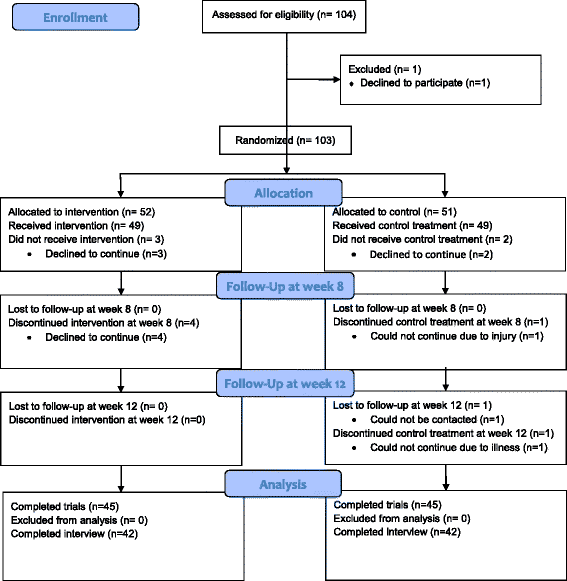On Your Feet to Earn Your Seat: pilot RCT of a theory-based sedentary behaviour reduction intervention for older adults
- PMID: 28491459
- PMCID: PMC5421328
- DOI: 10.1186/s40814-017-0139-6
On Your Feet to Earn Your Seat: pilot RCT of a theory-based sedentary behaviour reduction intervention for older adults
Abstract
Background: Of all age groups, older adults spend most of the time sitting and are least physically active. This sequential, mixed-methods feasibility study used a randomised controlled trial design to assess methods for trialling a habit-based intervention to displace older adults' sedentary behaviour with light activity and explore impact on behavioural outcomes.
Methods: Eligibility criteria were age 60-74 years, retired, and ≥6 h/day leisure sitting. Data were collected across four sites in England. The intervention comprised a booklet outlining 15 'tips' for disrupting sedentary habits and integrating activity habits into normally inactive settings, and eight weekly self-monitoring sheets. The control was a non-habit-based factsheet promoting activity and sedentary reduction. A computer-generated 1:1 block-randomisation schedule was used, with participants blinded to allocation. Participants self-reported sedentary behaviour (two indices), sedentary habit, physical activity (walking, moderate, vigorous activity) and activity habit, at pre-treatment baseline, 8- and 12-week follow-ups and were interviewed at 12 weeks. Primary feasibility outcomes were attrition, adverse events and intervention adherence. The secondary outcome was behavioural change.
Results: Of 104 participants consented, 103 were randomised (intervention N = 52, control N = 51). Of 98 receiving allocated treatment, 91 (93%; intervention N = 45; control N = 46) completed the trial. One related adverse event was reported in the intervention group. Mean per-tip adherence across 7 weeks was ≥50% for 9/15 tips. Qualitative data suggested acceptability of procedures, and, particularly among intervention recipients, the allocated treatment. Both groups appeared to reduce sedentary behaviour and increase their physical activity, but there were no apparent differences between groups in the extent of change.
Conclusions: Trial methods were acceptable and feasible, but the intervention conferred no apparent advantage over control, though it was not trialled among the most sedentary and inactive population for whom it was developed. Further development of the intervention may be necessary prior to a large-scale definitive trial. One possible refinement would combine elements of the intervention with an informational approach to enhance effectiveness.
Trial registration: ISRCTN47901994 (registration date: 16th January 2014; trial end date 30th April 2015).
Keywords: Behaviour change; Habit; Intervention; Older adults; Physical activity; Sedentary behaviour; Sitting.
Similar articles
-
Interventions for reducing sedentary behaviour in community-dwelling older adults.Cochrane Database Syst Rev. 2021 Jun 25;6(6):CD012784. doi: 10.1002/14651858.CD012784.pub2. Cochrane Database Syst Rev. 2021. PMID: 34169503 Free PMC article.
-
Acceptability of a theory-based sedentary behaviour reduction intervention for older adults ('On Your Feet to Earn Your Seat').BMC Public Health. 2015 Jul 2;15:606. doi: 10.1186/s12889-015-1921-0. BMC Public Health. 2015. PMID: 26135402 Free PMC article.
-
'On Your Feet to Earn Your Seat', a habit-based intervention to reduce sedentary behaviour in older adults: study protocol for a randomized controlled trial.Trials. 2014 Sep 20;15:368. doi: 10.1186/1745-6215-15-368. Trials. 2014. PMID: 25240737 Free PMC article. Clinical Trial.
-
'On Your Feet to Earn Your Seat': update to randomised controlled trial protocol.Trials. 2015 Aug 5;16:330. doi: 10.1186/s13063-015-0868-x. Trials. 2015. PMID: 26242218 Free PMC article. Clinical Trial.
-
Folic acid supplementation and malaria susceptibility and severity among people taking antifolate antimalarial drugs in endemic areas.Cochrane Database Syst Rev. 2022 Feb 1;2(2022):CD014217. doi: 10.1002/14651858.CD014217. Cochrane Database Syst Rev. 2022. PMID: 36321557 Free PMC article.
Cited by
-
Intervening to reduce sedentary behavior among African American elders: the "Stand Up and Move More" intervention.Health Promot Perspect. 2024 Jul 29;14(2):148-160. doi: 10.34172/hpp.42548. eCollection 2024. Health Promot Perspect. 2024. PMID: 39291047 Free PMC article.
-
Persons With Chronic Obstructive Pulmonary Disease and High Levels of Activation Improved Their Physical Activity Skills After an Educational Session.Chronic Obstr Pulm Dis. 2024 May 29;11(3):270-281. doi: 10.15326/jcopdf.2023.0456. Chronic Obstr Pulm Dis. 2024. PMID: 38527191 Free PMC article.
-
Interventions for reducing sedentary behaviour in community-dwelling older adults.Cochrane Database Syst Rev. 2021 Jun 25;6(6):CD012784. doi: 10.1002/14651858.CD012784.pub2. Cochrane Database Syst Rev. 2021. PMID: 34169503 Free PMC article.
-
A Systematic Review Examining the Relationship Between Habit and Physical Activity Behavior in Longitudinal Studies.Front Psychol. 2021 Mar 4;12:626750. doi: 10.3389/fpsyg.2021.626750. eCollection 2021. Front Psychol. 2021. PMID: 33746848 Free PMC article.
-
Older adults' construal of sedentary behaviour: Implications for reducing sedentary behaviour in older adult populations.J Health Psychol. 2021 Oct;26(12):2186-2199. doi: 10.1177/1359105320909870. Epub 2020 Mar 1. J Health Psychol. 2021. PMID: 32114825 Free PMC article.
References
Grants and funding
LinkOut - more resources
Full Text Sources
Other Literature Sources
Miscellaneous


